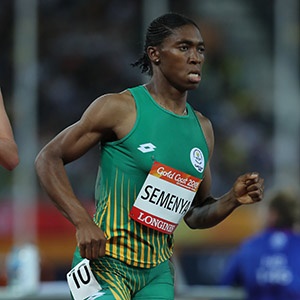Johannesburg - In 2009, when I moonlighted as a sports presenter on radio, a colleague and I conducted a telephonic interview with a teenage athlete named Caster Semenya, who had carried all before her at the African Junior Championships by winning the 800m and 1 500m double.
Having been told Semenya was a young woman, we were thrown by the fact that she sounded more like a man and had the diction of one, too. With radio often being fertile ground for puerile behaviour, we spent the rest of the interview exchanging knowing looks and stifling giggles.
My suspicion is that our reaction in studio that day was pretty much the same way most South Africans did when they first saw Semenya, whose only fault was reportedly being born with hyperandrogenism, which supposedly gives her more testosterone than her fellow female competitors.
But then something happened after the Berlin world championships that same year, where in the process of becoming world champion for the first time she was treated like a freak by fellow athletes, a Frankenstein experiment by the IAAF, and neglected by the then Athletics South Africa (ASA) leadership, who agreed that she be subjected to the humiliation of a gender test.
The nation rallied behind Semenya – now a multiple Olympic and world 800m champion – because she carried herself with strength and dignity belying her age throughout the fallout.
This week, convinced it had finally found the haymaker that would rid itself of Semenya and her “unfair” advantage after nine years of trying, the IAAF announced its latest eligibility regulations for female classification.
The new regulations, which come into effect on November 1 and have been dubbed the “Caster Rule” by suspicious South Africans, affect female competitors in the 400m, 400m hurdlers, 800m, 1 500m and the mile who have been deemed to have an unfair advantage owing to the testosterone levels in their system.
The eye-catching remedies for said athletes is scratching from the events at international level, taking medication to lower their testosterone levels, compete in men’s events or their own leper’s colony of “intersex” competitions.
Sports scientist Ross Tucker declared the study that enabled the IAAF to come to its conclusion as flawed, questioned a few inconsistencies and said he would be very surprised if the new regulations could stand up to a legal challenge in court.
The afterthought inclusion of the 1 500m, after Semenya began doubling up in major championships last year, on the list of affected events leads one to conclude that she is targeted, but there are other questions.
If Semenya’s dominance is as significant as it is suggested, why is it that she is still about two seconds off Jarmila Kratochvilova’s 35-year-old 800m world record and ranked joint 15th on the all-time list?
Given how suspicious Kratochvilova’s record was – she was 32 when she set it and claimed it was all down to copious amounts of vitamin B12 – one can’t help but draw the conclusion that Semenya is getting worse treatment than dopers.
More importantly, should the IAAF’s wish come true, the decision will almost affect average South Africans more than it does Semenya, who has won so much she would be an all-time great if she stopped running tomorrow.
The last nine years of Semenya’s life, a period in which she has evolved from an awkward, defensive, teenager to someone perfectly at ease with her “otherness”, have been an example to us all about how to negotiate our way through a murky underworld like our country, where change is the only constant.
By still marrying a woman when most people would have been browbeaten into pretending they preferred men because they were accused of walking, talking and acting like them, she has silently encouraged others to be true to themselves and their convictions.
Every day we see Semenya out there is a nod to living life on our own terms, getting up off the canvas when predictably knocked down and not judging one another solely because we are different.
Somehow in their over-eagerness to “inspire” career sixth-place finishers like Linsey Sharp – Semenya’s biggest detractor on track – by removing obstacles like the South African, the IAAF misses the opportunity to teach the kids watching their sport about real life.
sports@citypress.co.za
Follow me on Twitter @Simxabanisa




 Loading comments...
Loading comments...



































 How much of a runner are you?
How much of a runner are you?
